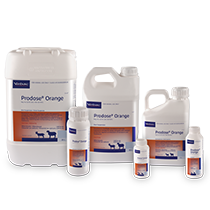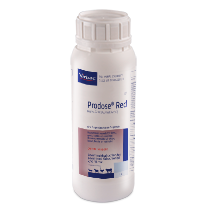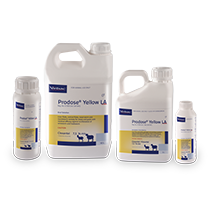
“Autumn disease” in sheep and goats and how to treat it.
This time of year there are many small stock farmers who regularly complain about animals with “a poach under the jaw” of their sheep or goats. “We are treating the sheep but we still struggle to get it under control” - we hear regularly. “What causes it and what can we do about it?”
Background
Wireworm (Haemonchus contortus) is a blood sucking roundworm. It is probably the internal parasite that has the biggest negative impact on sheep and goats in the summer rainfall in terms of annual production losses and mortalities (deaths).
The formation of pouches under the jaw or "bottlejaw" as it is commonly known, may have several causes. This time of year, especially when it has rained well, it is usually due to a severe wireworm infection. The pouch is due to the buildup of fluid. This is the direct result of anemia and loss of blood proteins caused by large numbers of wireworm. (See photos)
Lifecycle
The eggs that are excreted with the manure hatch under favorable conditions (moisture and temperature) as the L1 and L2 stages. It then develops into the infectious larval stage (L3) that climbs up to the grass and is then taken in by the sheep and goats along with the pasture. Within the animal it develops to the L4 and then to the adult stage. The adult females lay eggs (up to 10,000 per female per day), which are excreted again in the dung to complete the life cycle. Under favorable conditions, the cycle can be as short as 21 days. (See schematic representation)
Symptoms and Damage Caused
As mentioned before, the parasite is hemorrhagic. If the numbers within the animal increase drastically, it has a great negative effect on the sheep. The L4 and adults feed on blood from the intestine wall. (A 1000 worms can consume 50ml of blood a day!). Sheep therefore becomes anemic, listless and sluggish. Later, animals can weaken so much that they can no longer graze properly, develop bottlejaw (not all cases), and eventually die due to an oxygen deficiency, as there are too few red blood cells carrying oxygen.
NB. When conditions are favorable and grazing infestation is very high, the numbers inside the animal can increase so quickly that animals can die even before clinical signs are observed - especially when animals are being herded or stressed.
Production losses such as reduced wool growth and ADG also occur with low-grade persistent infestation. It can lower the milk production of ewes, resulting in lambs that grow weaker. The condition of the animals can also be affected in such a way that it can eventually result in reduced reproduction.
Determination and Monitoring of Contamination
Dung egg count:
The most common method used to determine the presence and degree of contamination is by means of a dung egg count. Although with a standard dung egg count only the amount of roundworm eggs (of which wireworm is one of the species) is determined, wireworm is usually the main cause of problems in the summer months in the summer rainfall area. Regular dung egg count analysis can serve as an early warning system. One thing to keep in mind is that the L4 stage also takes blood but does not yet lay eggs. It can therefore happen that with a sudden heavy infection, the animals can become anemic before a drastic increase in dung egg counts is observed!
FAMACHA:
This involves the regular examination of the animals' mucous membranes in the summer months to determine the degree of anemia (only applicable for wireworm infection). With training, the technique is fairly simple to master (must be executed correctly!). The mucosa of the third eyelid should be dark red to red in color. Once the color of the optic mucosa drops below a certain threshold (becomes pale), those animals must be individually marked and treated. (If these individuals need to be treated repeatedly, they should be culled.) Once a certain percentage of the herd becomes anemic, the entire herd can be treated to prevent losses.
Post-mortem:
A wireworm infection can be confirmed with a post-mortem. If present, wireworm will be observed mainly in the 4th stomach (melkpens). It is about a one to three centimeters long thread-like, round or cylindrical worm. The adult females have a distinctive red spiral around the body - hence the English description of "Barbers poles". (See photo)
Treatment
There are a few things to keep in mind during treatment:
-
Animals already anemic:
Animals that already show signs of anemia or develop malaise should be treated as soon as possible with a contact active. A contact cactive containing remedy is a product that contains an active that kills the wireworm on contact eg. Prodose Red’s Levamizole . After the blood levels have recovered, a product containing systemic actives (carried by blood proteins) can be administered (eg Prodose Orange / Yellow LA). If necessary (bottle jaw is not completely gone), the contact remedy may be repeated 10 days after the 1st treatment, followed by a systemic remedy dosed 10 days later. Supportive treatment with Vit B Co and Carmino+ will aid recovery.
NB. Remember to always take a dung sample from treated animals to be analyzed and again from the SAME animals 10 days later, to determine the efficacy of the drug used.
Animals not anemic:
If the dung egg count goes above >1500 eggs / g dung and conditions are favorable (rain, heat, grazing on planted pastures, persistent grazing, heavy pregnant ewes, lambs), expect a drastic increase in infestation. Under these circumstances you can think of treating the entire herd. If the animals' mucous membranes are not very pale or white (FAMACHA method) but still pink to pale pink, the animals can be treated with a systemic remedy eg. Prodose Orange / Yellow LA (which also has 35 residual action on wireworm).
Again, remember to take dung samples with treatment and again 10 days later from the same marked animals to determine the efficacy of the drug.
Factors that may affect the effectiveness of drugs:
-
Anemia:
In animals that are already anemic, the action of products containing active blood transport and killing the wireworm after ingestion of blood (systemic action), is not as effective. This can lead to animals still being able to die, even if treated. Then it is not necessarily the drug's fault.
-
Incorrect dose applied:
The mass of sheep must be determined to administer the correct dose according to the product's directions. Estimating weight can especially result in underdosing. If animals in the herd are reasonably uniform, the dose can be determined according to the heaviest sheep. If the animals are not uniform, they must first be sorted by mass or age groups and treated accordingly. Also, make sure the applicator is set correctly for the dose to be applied.
-
Faulty equipment:
Automatic dosing guns, especially if not thoroughly cleaned every time after use, may prevent the animals from receiving the correct dose (even if the syringe is set correctly!). Residues from previous use can impede the operation of the non return valve, so that a portion of the agent flows back into the container and only a portion physically ends up in the sheep's mouth! It is best to use a measure gauge to determine if the dose is consistent with that at which the syringe is set - BEFORE starting dosing.
With injectables, it can also happen that air enters the syringe. If not corrected, the animals will also not receive the correct dose. As with the dosing syringe, some of the drug may also flow back into the container instead of the full dose into the animal.
-
Not all sheep are treated:
Occasionally, the crush opens up, sheep get mixed up or animals are not present at all during treatment. Needless to say, these animals are not dosed and the drug cannot be blamed for inefficacy!
-
Incorrect application technique:
It is important to apply the correct techniques to ensure that the animal receives the full dose. With dosing, it may happen that the drug is being spewed during or immediately after dosing. Such animals should be retreated immediately. With the injectable agents, especially in wooled sheep with long wool (>4 months) and subcutaneous injection into the neck area, it is difficult to determine whether the drug is not leaking or injected through the skin. Such sheep are then not treated at all or at a lower dosage.
-
Resistance:
Some parasites have, for a variety of reasons, already developed resistance to certain actives and then the remedy used may be ineffective. That is why determining dung egg counts before/with AND after treatment (10 days later) is so important. If resistance is suspected after eliminating all the other factors mentioned above, it is recommended to perform a FECRT (fecal egg count reduction test) for the farm. This can determine which actives are still effective. (Contact your veterinarian or Virbac Technical Sales Advisor for assistance in this regard)
SUMMARY
During summer in the summer rainfall areas, wireworm can have devastating consequences. Wireworm is a blood sucking parasite that can cause production and physical losses. Often bottlejaw develop because of a lack of blood proteins and must be treated immediately!
Prevent major losses by:
- Performing regular dung egg counts in summer to gauge infection
- Using the FAMACHA method (weekly in peak wireworm season) to identify problem animals
- Treat animals with signs of bottle jaw or that are anemic (FAMACHA):
- Firstly with a contact remedy (i.e Prodose Red)
- Repeat the above after 10 days if symptoms of bottle jaw still prevail
- Follow up with systemic remedy 10 days later (i.e Prodose Orange)
- Take dung samples before/during AND 10 days after treatment from the SAME animals to measure product efficacy
- Always treat ALL animals CORRECTLY (according to mass, with well maintained equipment - measure dose beforehand, using the correct technique that prevents spillage of product etc.)
- If resistance is suspected, perform a FECRT to establish actives that can be used. (Contact your local vet or Virbac TSA for assistance)



